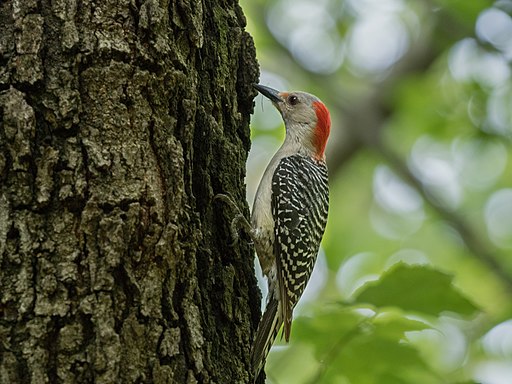Woodpeckers in Florida: Natural History, Ecology, and Preservation
Woodpeckers in Florida: Natural History, Ecology, and Preservation
Blog Article
Woodpeckers: A Comprehensive Overview to Comprehending These One-of-a-kind Birds
Woodpeckers, with their distinct actions and physical features, have actually long captivated the inquisitiveness of ornithologists and nature fanatics alike. As we check out the elaborate makeup, varied species, and environmental relevance of woodpeckers, a much deeper admiration for these distinct birds and the enigmas they hold unravels.

Woodpeckers' Drumming Habits
Woodpeckers exhibit a balanced and exact drumming habits that offers numerous necessary features in their daily lives. This actions is mostly connected with communication, territory protection, and foraging. The unique drumming audio is created by the quick pecking of their beaks against difficult surface areas such as tree trunks, branches, and even metal things.
Interaction is a critical facet of woodpecker habits, and drumming plays a considerable function in this process. Woodpeckers utilize drumming to establish their visibility, draw in friends, and keep contact with their partners and offspring. The regularity, intensity, and period of drumming sequences share details messages to various other woodpeckers in the location.
Along with interaction, woodpeckers utilize drumming actions for territory protection. Woodpeckers in Florida. The loud and repeated drumming offers as an advising to possible intruders, signaling that the location is already asserted. By developing their territory with drumming, woodpeckers reduce the probability of conflicts over important resources such as food and nesting sites
Moreover, woodpeckers likewise use drumming as a foraging method. The balanced pecking helps them locate insects hiding below the bark of trees by developing vibrations that interfere with the prey's camouflage. This behavior showcases the adaptability and ingenuity of woodpeckers in utilizing their drumming skills for numerous important objectives.
One-of-a-kind Adaptations for Tree Climbing
Having actually grasped the art of drumming to communicate, protect territory, and forage, woodpeckers have actually developed unique adaptations that facilitate their impressive climbing up abilities in their arboreal habitats. One essential adaptation is their specialized feet. Woodpeckers have zygodactyl feet, with 2 toes pointing forward and 2 toes aiming in reverse. This arrangement offers a solid hold on the vertical surface areas of trees, enabling them to stick easily while foraging for bugs or drumming. Furthermore, woodpeckers have rigid tail feathers that function as a prop to support their bodies as they climb up. These tail plumes supply stability and equilibrium, enabling woodpeckers to maneuver up tree trunks with accuracy and dexterity.
Moreover, woodpeckers have effective neck muscles and a distinct head framework that aid in their climbing up capabilities. Their strong neck muscles enable them to rapidly eat tree bark without experiencing whiplash, while their thick skull and tiny mind work as shock absorbers, safeguarding them from informative post the effect of duplicated drumming. These adaptations collectively enable woodpeckers to navigate the upright world of trees with effectiveness and elegance.

Role of Woodpeckers in Ecological Communities
By foraging for bugs under the bark of trees, woodpeckers help manage parasite populaces, stopping break outs that can harm the overall health of the forest. Furthermore, woodpeckers produce tooth cavities in trees that serve as essential nesting websites for a variety of other bird species, advertising biodiversity within the ecosystem.
Furthermore, the drumming and articulations of woodpeckers play a vital role in interaction and region establishment. These sounds not only offer to bring in friends but also help specify boundaries between different woodpecker regions, minimizing conflicts and article source promoting an unified conjunction within the woodland community. On the whole, the visibility of woodpeckers in woodland ecosystems highlights their value as keystone varieties, influencing the dynamics and operating of these environments in diverse means.
Makeup: Specialized Beaks and Feet
In the detailed internet of forest environments, the specialized beaks and feet of woodpeckers are essential adjustments that enable them to meet their crucial ecological roles. Woodpeckers have distinct anatomical attributes that are especially developed to help them in their foraging and nesting behaviors.
The most unique attribute of woodpeckers is their solid, chisel-shaped beaks. These beaks are perfectly adjusted for exploration into wood to reveal insects, larvae, and sap hidden below the bark of trees. The solid muscle mass and strong framework of their beaks allow woodpeckers to peck at a price of up to 20 times per secondly without creating damages to their heads.
Furthermore, woodpeckers have specialized feet that help in their acrobatic climbing up capabilities. Their feet have 2 toes pointing ahead and 2 toes aiming backward, supplying a solid grip on upright surfaces (Woodpeckers in Florida). This unique foot plan, in addition to tight tail feathers that function as a supportive prop, permits woodpeckers to hold on to tree trunks and branches with simplicity while they look for food or dig deep into nesting cavities
Woodpecker Species Variety
Woodpeckers are a varied team of birds found across different ecosystems worldwide, with over click this link 200 well-known types displaying adjustments to different environments. Woodpeckers have actually developed to populate an array of environments, from woodlands and timberlands to grasslands and deserts, each offering distinct obstacles that have actually influenced the development of distinct woodpecker varieties.
One more contributing variable to woodpecker species diversity is their specialized feeding habits. Different types have actually progressed to make use of numerous food resources, such as pests, tree sap, fruits, and nuts, leading to the growth of specific adaptations in beak shape, size, and toughness. These adjustments enable woodpeckers to forage successfully in their corresponding environments, minimizing competitors amongst varieties and promoting particular niche distinction. Furthermore, geographic isolation and historical aspects have contributed fit the circulation and variety of woodpecker types, causing the large range of specialized adjustments seen in these remarkable birds.

Conclusion
In final thought, woodpeckers are remarkable birds that exhibit unique drumming habits, specialized adjustments for tree climbing, and play important functions in ecosystems. With a diverse array of woodpecker varieties found worldwide, these birds are essential for preserving the wellness and equilibrium of forests and woodlands.
Report this page